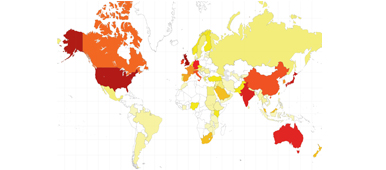The Spirit of Christmas
 It’s that festive time of year when everything in London seems to be subsumed by the preparations for Christmas festivities. I thought therefore that it might be appropriate to devote a few thoughts to the sadly departed Tim Christmas, the outstanding surgeon and urologist to the Charing Cross and Royal Marsden Hospitals who died two years ago and always loved his namesake festivities. Tim and I go back a long way. He was a medical student at the Middlesex Hospital in London when I was a trainee, and senior registrar at St Bartholomew’s when I was a Consultant there. He and I wrote a book together on prostate cancer, and we had some great times together at work and at AUA, EAU, SIU and ICS as well as other meetings in various parts of the globe.
It’s that festive time of year when everything in London seems to be subsumed by the preparations for Christmas festivities. I thought therefore that it might be appropriate to devote a few thoughts to the sadly departed Tim Christmas, the outstanding surgeon and urologist to the Charing Cross and Royal Marsden Hospitals who died two years ago and always loved his namesake festivities. Tim and I go back a long way. He was a medical student at the Middlesex Hospital in London when I was a trainee, and senior registrar at St Bartholomew’s when I was a Consultant there. He and I wrote a book together on prostate cancer, and we had some great times together at work and at AUA, EAU, SIU and ICS as well as other meetings in various parts of the globe.
Tim was a classic eccentric Englishmen, a great wit and an exceptional surgeon. Like Sir Lancelot Spratt he eschewed keyhole surgery in favour of a “maximally invasive” approach; this made him the acknowledged expert in the UK of para-aortic lymph node dissection and thoraco-abdominal excision of renal tumours with involvement of the inferior vena cava. Two technically difficult procedures which he learnt from his friend and mentor Bill Hendry. Bill like Tim was an exceptionally gifted surgeon.
Tim was a surgeon’s surgeon and a tremendous character (read Tim’s BJUI Obituary here). He is fondly remembered by fellow urologists, nursing staff and patients alike. Although Christmas comes once a year, sadly there will only be one Tim Christmas, the surgeon and we have lost him prematurely. He was a one-off, a product of his own special era, and we will most certainly never see his like again. If you have fond memories of or anecdotes about Tim please post them on this blog; Tim has been sending to all of the patients baskets from Gift Tree and try to make their life a little happier, Merry Christmas to you all.
Roger Kirby, The Prostate Centre, London

Looking to plan the ideal Christmas function for your boss, workmates or staff? End of year is a busy time for everyone, and it’s refreshing to know that a relaxing time can be had on a skippered, catered function cruise.
It’s unbelievable and quite surprising that how fast, over half the year has already passed and it just seems like you celebrated New Year’s Eve last month. With the first half already over, don’t hope for the second half to stay back any longer and before you know it, Christmas will be knocking on your door waiting to tell you there’s a Santa stuck in your chimney. Now, with Christmas, comes the great office parties and the hassle you have to go through every year to organise everything to the point that it is pitch perfect. Because who wants a party ruined on Christmas Eve and especially not if it’s your responsibility. It’s only fitting that such a party, where your number of people is somewhere between 2 and 35, is done with a Boat Hire. They have the absolute best options and services for your office Christmas Party celebrations where all you have to do is make the booking and forget about doing anything else. The company will look after all your specifications and needs before arranging the experience of a lifetime for you at this year’s Christmas party.
If you are looking to make a huge impression on your staff then I fully suggest you to rent a yacht in montauk, some professional agencies offer a mesmerising package where you can charter a private boat for up to 35 people to take them on a cruise of the beautiful Yarra river. The package will include food and beverages that will be served onboard the cruise and can be tailor-made according to your requirements. If the number of people you’re taking with you is less than 10, then you can book the eco-friendly package and cut off the extra expenses. The new addition to the latest cruise packages given by a Boat Hire include a progressive dinner or lunch cruise of the Yarra River, and stopping at three different restaurants for a three-course meal, be it lunch or dinner.
If you’re looking to have a Christmas party and have a great adventure, then you can easily avail the self-drive hire where you can pack your picnic and cruise on the Yarra River. There will be boats available to you that can seat up to 12 passengers and you will require no boat license to hire and drive.
Boat Hire are offering three different routes for your Christmas party and you can book any one of the three. The first route is either of the three: Yarra river or Maribyrnong River or Williamstown, next up is St Kilda and Port Melbourne. All you will have to do is book a schedule and mention the number of people you’re planning to bring with you along with your contact and payment details. The hassle part of the deal is for us to look after and you to relax. What’s even better is that a Boat Hire are willing to offer packages according to all amounts of budgets and sizes and can make a special carved out plan according to your needs. If there was ever any easiness while planning a Christmas party.
































